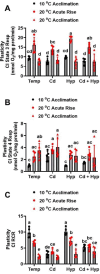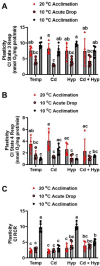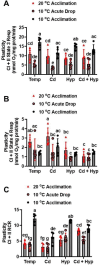This is a preprint.
Interactive effects of temperature, cadmium, and hypoxia on rainbow trout (Oncorhynchus mykiss) liver mitochondrial bioenergetics
- PMID: 39071258
- PMCID: PMC11275722
- DOI: 10.1101/2024.07.15.603625
Interactive effects of temperature, cadmium, and hypoxia on rainbow trout (Oncorhynchus mykiss) liver mitochondrial bioenergetics
Update in
-
Interactive effects of temperature, cadmium, and hypoxia on rainbow trout (Oncorhynchus mykiss) liver mitochondrial bioenergetics.Ecotoxicol Environ Saf. 2025 Jan 1;289:117450. doi: 10.1016/j.ecoenv.2024.117450. Epub 2024 Dec 3. Ecotoxicol Environ Saf. 2025. PMID: 39632330 Free PMC article.
Abstract
Fish in their natural environments possess elaborate mechanisms that regulate physiological function to mitigate the adverse effects of multiple environmental stressors such as temperature, metals, and hypoxia. We investigated how warm acclimation affects mitochondrial responses to Cd, hypoxia, and acute temperature shifts (heat shock and cold snap) in rainbow trout. We observed that state 3 respiration driven by complex I (CI) was resistant to the stressors while warm acclimation and Cd reduced complex I +II (CI + II) driven state 3 respiration. In contrast, state 4 (leak) respirations for both CI and CI + II were consistently stimulated by warm acclimation resulting in reduced mitochondrial coupling efficiency (respiratory control ratio, RCR). Warm acclimation and Cd exacerbated their individual effect on leak respiration to further reduce the RCR. Moreover, the effect of warm acclimation on mitochondrial bioenergetics aligned with its inhibitory effect on activities of citrate synthase and both CI and CII. Unlike the Cd and warm acclimation combined exposure, hypoxia alone and in combination with warm acclimation and/or Cd abolished the stimulation of CI and CI + II powered leak respirations resulting in partial recovery of RCR. The response to acute temperature shifts indicated that while state 3 respiration returned to pre-acclimation level, the leak respiration did not. Overall, our findings suggest a complex in vivo interaction of multiple stressors on mitochondrial function that are not adequately predicted by their individual effects.
Keywords: Acclimation; Cd; Hypoxia; Mitochondrial bioenergetics; Plasticity; Rainbow trout.
Conflict of interest statement
Declaration of competing interest The authors declare no conflict of interest.
Figures







References
-
- Adiele R.C., Stevens D., Kamunde C., 2010. Reciprocal enhancement of uptake and toxicity of cadmium and calcium in rainbow trout (Oncorhynchus mykiss) liver mitochondria. Aquat. Toxicol. 96: 319–327. - PubMed
-
- Adiele R.C., Stevens D., Kamunde C. (2012). Differential inhibition of electron transport chain enzyme complexes by cadmium and calcium in isolated rainbow trout (Oncorhynchus mykiss) hepatic mitochondria. Toxicol. Sci. 127: 110–119. - PubMed
-
- Belyaeva E.A., Korotkov S.M., 2003. Mechanism of primary Cd2+-induced rat liver mitochondria dysfunction: discrete mode of Cd2+ action on calcium and thiol-dependent domains. Toxicol. Appl. Pharmacol. 192: 56–68. - PubMed
-
- Bouchard P., Guderley H., 2003. Time course of the response of mitochondria from oxidative muscle during thermal acclimation of rainbow trout, Oncorhynchus mykiss. J. Exp. Biol. 206: 3455–3465. - PubMed
Publication types
Grants and funding
LinkOut - more resources
Full Text Sources
